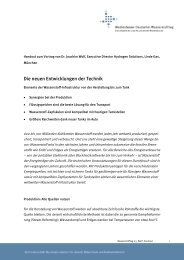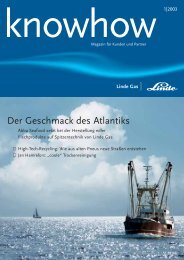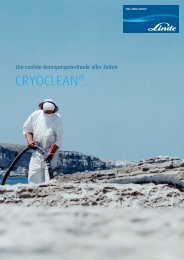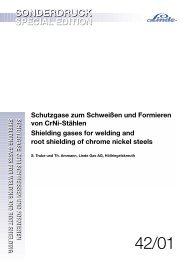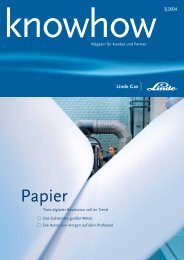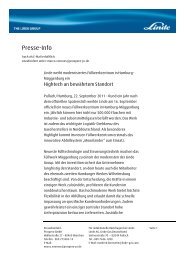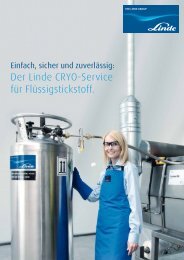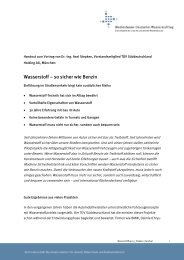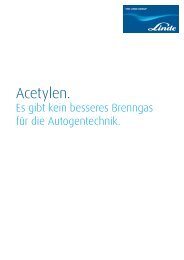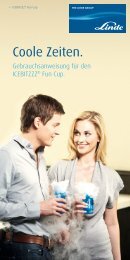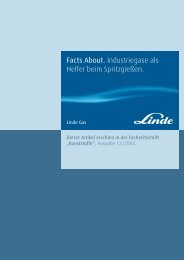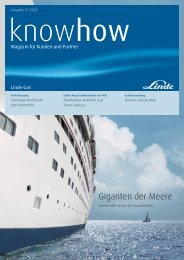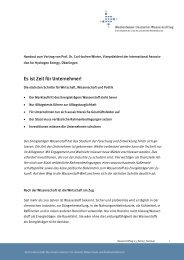Auswahl von Schutzgasen zum Schweißen von Stahlwerkstoffen A ...
Auswahl von Schutzgasen zum Schweißen von Stahlwerkstoffen A ...
Auswahl von Schutzgasen zum Schweißen von Stahlwerkstoffen A ...
Sie wollen auch ein ePaper? Erhöhen Sie die Reichweite Ihrer Titel.
YUMPU macht aus Druck-PDFs automatisch weboptimierte ePaper, die Google liebt.
low-spatter in argon-oxygen mixtures. Due to the requirement<br />
of reduced amount of slag on weld surfaces, especially in the<br />
automotive industry, a general trend to gas mixtures with low<br />
CO 2 additions can be observed, whereby spattering is reduced,<br />
too.<br />
For use on rusty, scaled and/or oily base material, an increase<br />
of the CO 2 percentage to 18 - 25 % will be of benefit to ensure<br />
low porosity. Especially for primered plates (shipbuilding),<br />
argon mixtures with up to 40 % CO 2, and even pure CO 2 in<br />
conjunction with solid or cored wire are employed to ensure<br />
low porosity welds.<br />
Ar/O 2/CO 2: Ternary gas mixtures had been developed to try<br />
and combine low-spatter welding in Ar/O 2 shields with low<br />
porosity, high travel speed and adequate weld penetration in<br />
CO 2 shielding. There are two basic groups of ternary mixtures<br />
in use.<br />
The first group originates in a development of the late fifties<br />
(15 % CO 2/5 % O 2/80 % Ar). The actual trend changes over<br />
to additions of 10 - 15 % CO 2 and 3 - 6 % O 2 to argon. This<br />
group of mixtures is mainly used on scaled and/or greasy surfaces,<br />
and on heavy sections.<br />
The second group of argon-carbon dioxide-oxide mixtures is<br />
used on clean sheets and plates, and is typical of lowest spatter<br />
levels. These mixtures contain 3 - 6 % CO 2, 1 - 4 % O 2,<br />
and argon. Because of the lower active gas (CO 2, O 2) percentages,<br />
slag levels are also reduced compared to the<br />
formerly described group of mixtures.<br />
Ar/He/O 2/CO 2: The quarternary gas mixture T.I.M.E. had<br />
been developed for high performance MAG welding. In addition<br />
to the known effects obtained with CO 2 and O 2, helium<br />
was added to the mixture to improve the wetting properties of<br />
the weld, i.e. helium additions help obtain a broad penetration<br />
profile.<br />
However, latest advances in the field of high performance<br />
MAG welding have shown that the rotating arc movement can<br />
be stabilized by employing argon-helium-oxygen mixes, the<br />
spray arc by using argon-helium-carbon dioxide mixtures<br />
[12]. This complex subject of shielding gases for high performance<br />
MAG welding has been explained in detail in [13].<br />
Shielding gas types and their important features in structural<br />
steel welding are once more clearly scheduled in table 2, the<br />
properties of shielding gas mixtures to EN 439 in table 3.<br />
� TIG/structural (carbon) steel<br />
Ar: Argon is a shielding gas very frequently used in TIG welding<br />
structural steels. When the technological limitations of the<br />
process are observed, the resulting weld will be finely rippled,<br />
exhibiting low porosity and minimum slag depositions on the<br />
weld surface. Due to poor heat transfer and the low ionization<br />
potential of argon, maximum travel speed rates are rather low,<br />
especially where cold wire is added.<br />
Ar/He: In these mixtures, 30 - 50 % helium is generally<br />
added. He additions lead to a broader weld contour and let<br />
obtain increased travel speed rates compared with pure<br />
argon.<br />
Ar/H 2 (He): Altough hydrogen is feared for the risk of producing<br />
hydrogen-induced cracking, such mixtures are quite commonly<br />
employed in sheet metal welding (e.g. for longitudinal<br />
tube welds using multi-cathode TIG torches). By increasing<br />
the hydrogen percentage in the mixture, travel speed rates<br />
can also be increased considerably. The maximum H 2 content<br />
that can be added varies with the welding job, material type,<br />
metal thickness, level of porosity, etc; commonly, it will not<br />
exceed 10 % significantly. Because of the high travel speed<br />
rates that can be achieved with argon-hydrogen mixtures,<br />
they will be employed mainly for fully mechanized welding<br />
operations.<br />
� MIG/MAG/high alloy CrNi steel<br />
Ar: Argon is used for some applications, but here again, poor<br />
arc stability is found in the absence of an active gas addition;<br />
weld pools are very viscous, and the weld-to -base metal joint<br />
pattern is very irregular.<br />
Ar/O 2 (He): The classical mixture type contains 1 to 3 % oxygen<br />
for improved arc stabilization. However, adverse effects<br />
are low heat input, high degree of oxidation and the strong<br />
tendency for porosity to occur. The low heat input can be<br />
balanced by adding helium, which at the same time will improve<br />
wetting properties, and increase travel speed rates.<br />
Gas mixtures containing more than 3 % oxygen are also applicable,<br />
producing, however, heavy weld surface oxidation.<br />
Such oxidation coatings after welding can only be removed<br />
mechanically, pickling is not possible any more.<br />
Symbol Components in percent volume Suitable for<br />
CrNi steel and Ni base alloys<br />
Group Identity inert reducing Application directives<br />
No.<br />
Ar He H2 1 Balance1) > 0 - 15 increasing H2 additions to the gas mixture increases<br />
arc efficiency, i.e. penetration profile<br />
R<br />
2 Balance<br />
and travel speed rate, mix with H2 over 5 %<br />
1) > 15 - 35 is preferred in fully mechanized (machine) welding.<br />
1) Argon may be replaced by up to 95 % helium.<br />
Shielding gas<br />
Backing gas<br />
(Förster)<br />
Table 5<br />
Application directives for gas mixtures containing H 2 used in TIG welding of CrNi steel.<br />
Wall thickness 2 mm,<br />
without filler material<br />
Fig. 2 - Ferrite reduction and control through N 2 added to the<br />
shielding gas. Nitrogen in the backshielding gas has no effect<br />
on the weld ferrite.<br />
13



